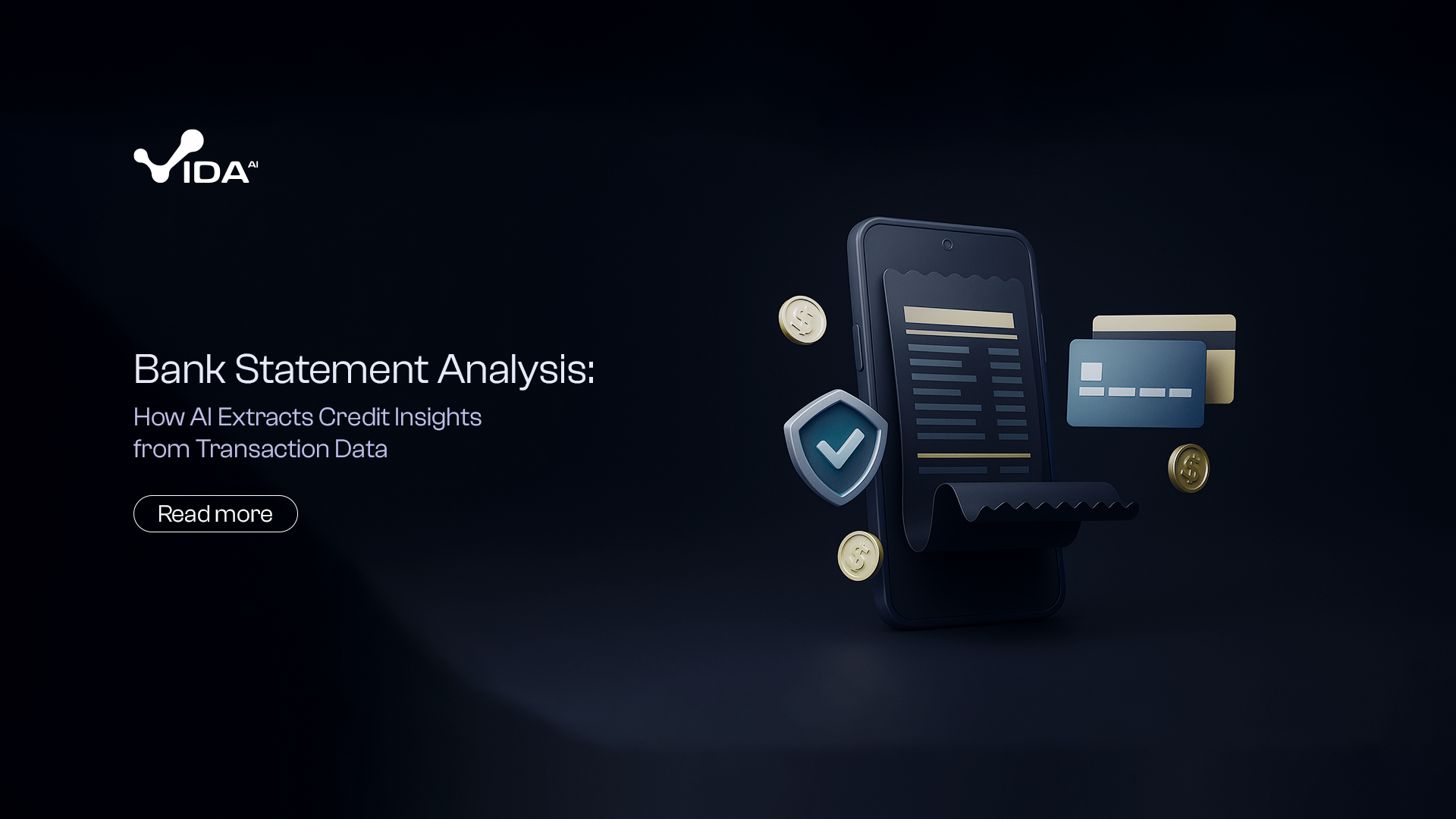back to Articles
Bank Statement Analysis: How AI Extracts Credit Insights from Transaction Data

Eniayewu Josephine
Content Writer
Bank statements contain rich financial narratives that traditional credit scoring largely ignores. Every transaction reveals spending patterns, income stability, and financial management capabilities that static credit reports cannot capture. AI-powered bank statement analysis transforms this untapped data source into actionable credit insights, enabling more accurate lending decisions while expanding access to credit for borrowers with limited traditional credit histories.
The Hidden Value in Transaction Data
Traditional credit evaluation relies heavily on payment history and outstanding balances, missing crucial information about borrower financial behavior. Bank statements reveal income consistency, spending patterns, savings behavior, and cash flow management that provide deeper insights into repayment capacity and financial responsibility.
Transaction patterns indicate employment stability through regular payroll deposits, freelance income predictability, and seasonal earnings variations. Automated analysis identifies income sources, frequency patterns, and trend directions that manual review cannot efficiently process at scale.
Spending categorization reveals financial priorities and management capabilities. Regular savings transfers, timely bill payments, and balanced spending across categories indicate financial discipline, while excessive discretionary spending or frequent overdrafts suggest elevated risk.
Cash flow analysis identifies the timing relationships between income and expenses that determine actual repayment capacity. Borrowers with steady income but poor cash flow timing may struggle with loan payments despite appearing creditworthy through traditional metrics.
AI-Powered Transaction Categorization
Machine learning algorithms automatically categorize thousands of transactions into meaningful spending groups with accuracy exceeding 95%. Natural language processing analyzes merchant names, transaction descriptions, and payment methods to identify expense categories reliably.
Advanced categorization goes beyond basic groupings like groceries or entertainment to identify subcategories that reveal deeper financial insights. Restaurant spending patterns, luxury purchases, subscription services, and investment activities each provide unique risk indicators.
Merchant recognition systems identify specific retailers, service providers, and financial institutions from transaction descriptions. This granular analysis reveals shopping preferences, service usage patterns, and banking relationships that inform creditworthiness assessment.
Transaction timing analysis identifies payment behaviors that indicate financial management capabilities. Automatic payments, early bill payment, and consistent timing patterns suggest organized financial management, while erratic payment timing may indicate cash flow challenges.
Income Verification and Stability Assessment
Automated income detection identifies salary deposits, freelance payments, benefits, and other income sources with high accuracy. Pattern recognition algorithms distinguish between wages, bonuses, tax refunds, and irregular income sources that require different risk assessment approaches.
Income stability scoring evaluates consistency over time, identifying seasonal patterns, growth trends, and volatility measures that affect repayment capacity. Traditional employment verification captures a single point in time, while transaction analysis reveals income patterns over extended periods.
Multiple income source identification reveals diversification that may reduce default risk or complexity that increases management challenges. Gig economy workers with multiple income streams require specialized analysis that traditional underwriting approaches cannot provide effectively.
Irregular income smoothing techniques help assess repayment capacity for borrowers with variable earnings. AI models identify underlying income trends despite month-to-month fluctuations, enabling more accurate affordability calculations.
Expense Analysis and Cash Flow Management
Automated expense categorization reveals spending priorities and financial management effectiveness. Fixed expenses like rent and utilities indicate baseline financial commitments, while discretionary spending patterns show financial discipline and budget adherence.
Debt service identification through transaction analysis provides more accurate debt-to-income calculations than credit reports alone. Actual payment amounts may differ from reported minimum payments, affecting true financial capacity assessment.
Overdraft and fee analysis indicates cash flow management effectiveness and potential financial stress. Frequent overdrafts suggest cash flow problems despite adequate income, while minimal fees indicate effective financial management.
Savings behavior analysis through transaction patterns reveals long-term financial planning capabilities. Regular savings transfers, retirement contributions, and emergency fund building indicate financial responsibility and forward-thinking behavior.
Risk Indicators and Red Flags
AI systems identify concerning transaction patterns that indicate elevated credit risk. Unusual cash withdrawals, gambling transactions, frequent money transfers, and inconsistent income sources trigger additional scrutiny and risk assessment.
Fraud indicators include transactions inconsistent with stated income levels, rapid spending increases, and patterns suggesting identity theft or account takeover. Early detection prevents losses while protecting legitimate borrowers from identity theft consequences.
Financial stress signals emerge through transaction analysis before they appear in credit reports. Increased cash advances, missed automatic payments, and reduced savings transfers indicate developing financial difficulties that may affect loan performance.
Money laundering and suspicious activity detection protects lenders from regulatory violations and reputational damage. AI systems identify unusual transaction patterns that may indicate illegal activity or regulatory compliance issues.
Technology Infrastructure for Statement Analysis
Optical character recognition (OCR) technology converts PDF bank statements into structured data for analysis. Advanced OCR systems handle various bank formats, foreign languages, and image quality issues that affect data extraction accuracy.
Data standardization processes normalize transaction data across different banks and account types. Standardized formats enable consistent analysis regardless of the original bank's data presentation or terminology.
Real-time API integration with banks and financial institutions enables immediate access to transaction data with customer consent. Open banking initiatives expand these capabilities, providing standardized access to financial data across institutions.
Security measures protect sensitive financial data throughout the analysis process. Encryption, access controls, audit trails, and data retention policies ensure regulatory compliance and customer privacy protection.
Integration with Lending Workflows
Automated underwriting systems incorporate transaction analysis insights alongside traditional credit metrics for comprehensive risk assessment. Weighted scoring models balance traditional credit information with transaction-based insights for optimal accuracy.
Loan pricing optimization uses transaction analysis to identify lower-risk borrowers who qualify for preferred rates despite limited credit history. More accurate risk assessment enables competitive pricing that attracts quality borrowers while maintaining portfolio profitability.
Exception handling processes manage incomplete data, technical errors, and unusual account structures that may affect analysis accuracy. Clear escalation procedures ensure complex cases receive appropriate human review without delaying straightforward applications.
Customer consent management ensures transparent data usage while maintaining regulatory compliance. Clear privacy policies, opt-in procedures, and data retention controls build customer trust while enabling valuable analysis capabilities.
Measuring Analysis Effectiveness
Predictive accuracy improvements measure how transaction analysis enhances traditional credit scoring effectiveness. A/B testing compares loan performance between traditional and enhanced underwriting approaches to quantify benefits.
Portfolio performance metrics track default rates, charge-off amounts, and profitability across different analysis methodologies. Long-term tracking validates transaction analysis value through actual loan performance data.
Operational efficiency measures include processing time reductions, manual review requirements, and customer satisfaction improvements. Cost-benefit analysis quantifies technology investments against operational savings and risk reduction benefits.
False positive and false negative rates indicate analysis accuracy and fairness. Continuous monitoring ensures systems maintain performance standards while identifying areas for improvement.
Future Developments in Transaction Analysis
Real-time transaction monitoring could enable dynamic credit limit adjustments and early intervention for borrowers experiencing financial difficulties. Continuous risk assessment based on ongoing transaction patterns provides proactive portfolio management capabilities.
Predictive cash flow modeling using transaction history could forecast future financial capacity more accurately than current income-based assessments. Machine learning models incorporating seasonal patterns, trend analysis, and economic indicators may improve long-term risk assessment.
Cross-institutional data aggregation through open banking initiatives will provide more comprehensive financial pictures for borrowers with multiple banking relationships. Consolidated analysis across all accounts eliminates information gaps that affect risk assessment accuracy.
Bank statement analysis through AI represents a transformative advancement in credit risk assessment, unlocking valuable insights hidden within routine financial transactions. Lenders implementing these capabilities gain competitive advantages through improved accuracy, expanded market reach, and enhanced portfolio performance.
Sign Up Here to use AI for bank statement analysis that improves approval accuracy and reduces risk.

